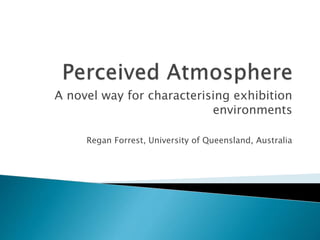
Measuring Visitor Perceptions of the Exhibition Environment
- 1. A novel way for characterising exhibition environments Regan Forrest, University of Queensland, Australia
- 3. Person-in- Environment • Environmental Properties • Visitor (Consumer) Needs • Intended Atmosphere Perceived Atmosphere Visitor Responses • Affective • Cognitive • Behavioural Adapted from Kotler, 1974; reviewed in Forrest, 2013 A Model for “Museum Atmospherics”
- 4. Build upon existing qualitative research (e.g. Packer, 2008; Roppola, 2012) Existing quantitative research has focused on relating a “good” environment to marketing-related outcomes (e.g. Bonn et al 2007) “Good” doesn’t tell a designer much – can Perceived Atmosphere offer a better snapshot?
- 5. Qualitative research exploring how visitors describe exhibition environments Pilot test terminology as semantic differentials and Likert scales (n=172) Refine word list to produce 30 semantic differentials (7-point scales) e.g. Dark-Light; Active-Passive; Linear-Winding Use in visitor survey across four exhibition galleries at South Australian Museum (n=602)
- 6. “Measurement of Meaning” (Osgood et al, 1957) Colour emotion research ◦ Activity, Potency, Temperature Retail lighting design – “atmosphere metrics” ◦ Cosiness, Liveliness
- 7. Factor 1 2 Dramatic-Plain .719 Active-Passive .712 Vibrant-Dull .705 Ordinary-Striking -.597 Dynamic-Static .583 Colourful-Neutral .572 Energetic-Serene .515 Flat - 3-Dimensional -.442 Varied-Repetitive Subdued-Bright Cosy-Formal Simple-Complex Small scale-Large scale Wide-Narrow .704 Spacious-Confined .672 Open-Enclosed .509 Cluttered-Uncluttered -.462 Hidden-Obvious Factor 3 4 Linear-Winding .584 Traditional-Modern .545 Symmetrical-Asymmetrical .538 Evenly Lit-Targeted Lighting .518 Dark-Light -.498 Old-New .473 Warm-Cool Hard-Soft Ordered-Jumbled .777 Organised-Random .622 Structured-Unstructured .524 Flowing-Discontinuous .454 Principal Axis Factoring with Varimax rotation. Factor loadings below 0.4 are suppressed.
- 8. Vibrancy ◦ Dramatic, Active, Vibrant, Striking, Dynamic, Colourful, Energetic, Three-Dimensional Spatiality ◦ Wide, Spacious, Open, Uncluttered (the variable formerly known as) Modernity (Theatricality?) ◦ Winding, Modern, Asymmetrical, Targeted Lighting, Dark, New Order ◦ Ordered, Organised, Structured, Flowing
- 9. No gender difference besides a slightly higher spatiality rating from females Perceptions of vibrancy increase (a bit) with age No apparent differences according to visiting group, history of visiting SA Museum or reason for visiting
- 10. Perceived Atmosphere – Gallery Comparisons (Zero = neutral score on 7-point Likert scale) -1 -0.5 0 0.5 1 1.5 AACG-G AACG-1 PCG SABG Individual Gallery Comparisons Modernity Vibrancy Order Spatiality
- 11. Pacific Cultures (PCG) Lowest Vibrancy Most Traditional (least Theatrical) Moderate-High Spatiality Moderate-High Order
- 12. Aboriginal Cultures-1 Moderate Vibrancy Moderate – High Spatiality Moderate Theatricality Moderate-High Order
- 13. Aboriginal Cultures - G Moderate Vibrancy Moderate Spatiality Moderate Theatricality Moderate-High Order
- 14. SA Biodiversity (SABG) Highest Vibrancy Lowest Spatiality Highest Theatricality (N.S) Moderate-High Order
- 16. Quick and easy to administer A “macro” perception of the exhibition environment that is content-neutral A visitor-centric way of comparing, benchmarking and evaluating exhibition environments
- 18. More exhibition types Temporary exhibition galleries Travelling exhibitions This is where you come in!
- 20. Independent variables ◦ Vibrancy (8 items as semantic differentials) ◦ Spatiality (4 items as semantic differentials) ◦ Order (4 items as semantic differentials) Dependent variables ◦ Cognitive Engagement (7 environmental cognition statements) ◦ Affective Engagement (8 emotion items as semantic differentials) ◦ Relaxation (5 items as semantic differentials) ◦ Cognitive Overload (4 environmental cognition statements) ◦ Displeasure (8 emotion items as semantic differentials)
- 21. DVs 1. Cognitive Engagement 2. Cognitive Overload 3. Affective Engagement 4. Relaxation 5. DispleasureIVs Vibrancy .63 -.23 .52 .22 -.24 Order .17 -.36 .16 .15 -.12 Spatiality .09 -.15 .12 .26 -.11 Adjusted R2 .56 .35 .43 .23 .13
